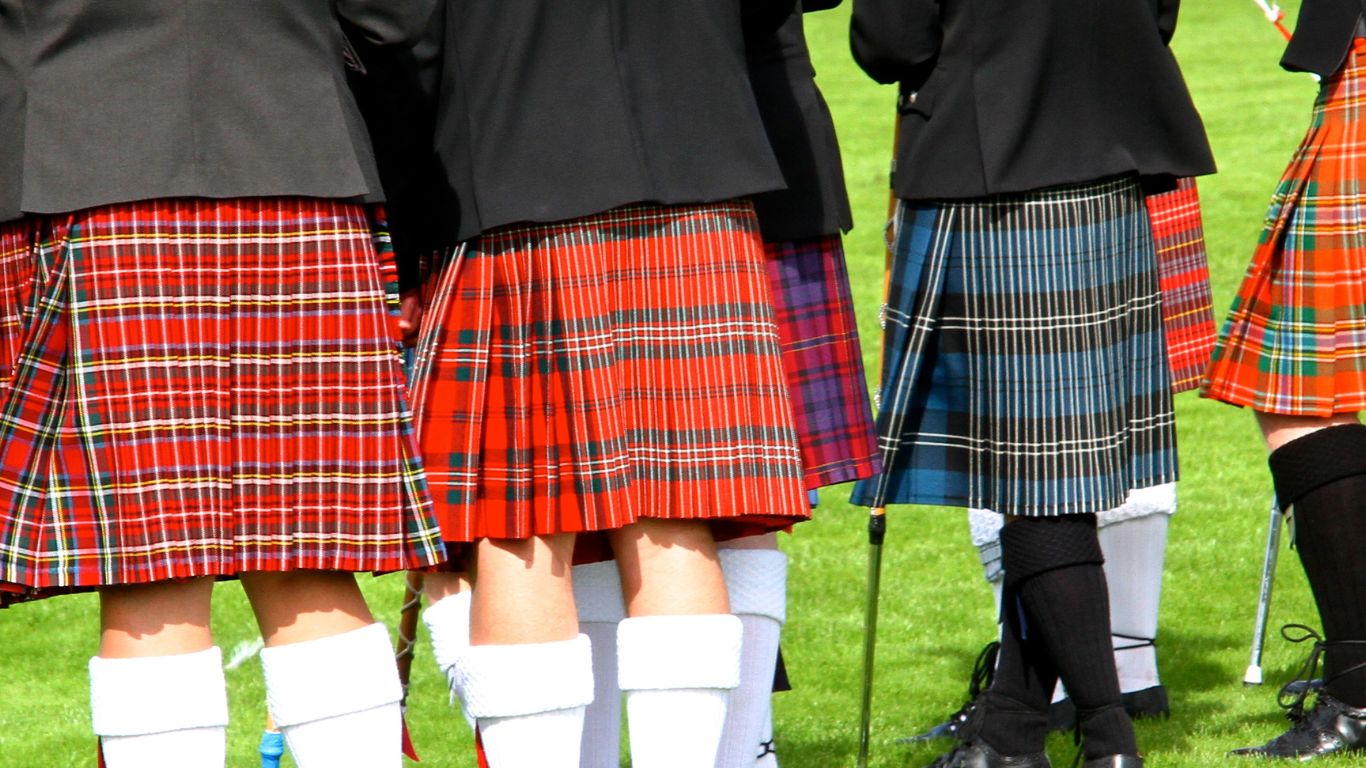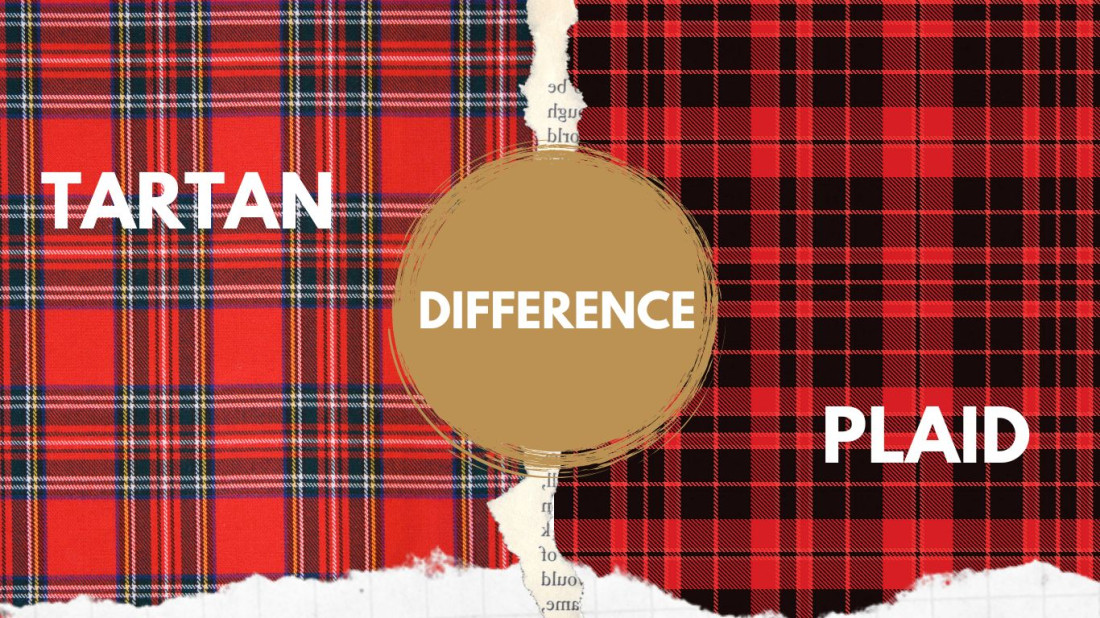When it comes to traditional and timeless patterns in the world of fashion and textiles, few can rival the enduring appeal of tartan and plaid. These two patterns have captured the hearts of many with their rich history, cultural significance, and versatile use in various products.
While often used interchangeably, tartan and plaid are distinct patterns with unique origins and characteristics. This comprehensive guide will explore the world of tartan vs plaid, browsing their histories, differences, and common misconceptions.
What Is Tartan: A Glimpse into Its History:

Tartan, characterized by its crisscrossing horizontal and vertical stripes, finds its origins in the Scottish Highlands. It was initially used to identify clans and distinguish one's affiliation. The intricate patterns were created using traditional weaving techniques and natural dyes, resulting in a spectrum of colors that held symbolic meanings.
The origins of tartan, including the iconic tartan kilt, trace back to ancient Scotland, where the pattern served a functional purpose before becoming a fashion statement. The woven fabric, adorned with distinctive patterns of intersecting lines, initially served as a garment for protection against the harsh Highland climate.
Over time, however, tartan evolved into much more than a practical piece of clothing; it became a symbol of familial and regional pride.
Plaid: Unraveling Its Origins:
Plaid, rooted in the Scottish Highlands, began as a utilitarian necessity, adapting to the challenging weather conditions and rugged landscapes. Originally, the term "plaid" referred not to the pattern itself but to the outer layer, often a plaid kilt, worn by Scottish Highlanders over their shoulders.
This outer layer, known as "feileadh-mór" in Gaelic, was not merely a garment; it was a versatile and indispensable tool for daily life. The harsh environment of the Highlands demanded attire that could withstand unpredictable weather and provide functional flexibility.
The plaid, often made from durable wool, was ingeniously designed to be a multitasking essential. Its purpose extended far beyond conventional clothing – it served as a cloak, a blanket, a tartan kilt, and a makeshift bag for carrying personal belongings. This adaptability was a testament to the resourcefulness of the Highlanders, who ingeniously utilized their clothing to meet a range of survival needs.
The "feileadh-mór" could be draped around the body for protection against the biting cold and biting winds. When the weather turned more favorable, it could be arranged as a blanket for sitting or resting. When the need arose, it seamlessly transformed into a storage space, with the wearer tying up the corners to create a makeshift pouch. This exceptional versatility made the plaid an inseparable part of daily life, embodying the resilience and practicality of the Highlanders.
As time progressed, the plaid underwent a metamorphosis from purely functional to a symbol of cultural pride and individual expression. Evolving fashion trends and a growing sense of identity drove the shift from rugged utility to stylish accessory.
The plaid's distinctive patterns and colors became intertwined with clan affiliations, reflecting the wearer's heritage and allegiances. This transformation marked the beginning of the plaid's journey from a protective layer to a statement piece that spoke volumes about one's background and beliefs.
The plaid's evolution from a pragmatic garment to a fashionable emblem epitomizes the ingenuity of the Scottish Highlanders. It's multifaceted utility and cultural significance showcase the rich tapestry of history woven into this iconic pattern.
As plaid continues to grace runways, homes, and various forms of artistic expression, it pays homage to its origins while demonstrating its remarkable adaptability across time and space.
Difference Between Plaid and Tartan: What Sets Them Apart:
While tartan and plaid may share intersecting lines in their designs, they possess distinctive characteristics that set them apart in complexity and cultural significance. With their roots entrenched in history, these patterns carry different aesthetics that cater to various styles and convey diverse messages.
Tartan: Intricate Symmetry with Cultural Depth:
Complex Design Structure:
Tartan patterns exhibit remarkable intricacy, often boasting a complex arrangement of intersecting lines, creating a visually captivating array of shapes.
Distinct Repeat Pattern:
Tartans are known for their repeated patterns that meticulously align horizontally and vertically, contributing to their intricate yet harmonious appeal.
Color Palette Significance:
The color palette of tartan is not only expansive but also holds deep significance. Different hues are used to represent specific clans, families, or regions, allowing individuals to communicate their affiliations visually.
Symbolism and Identity:
Each tartan carries a unique historical narrative, symbolizing the heritage and identity of the group it represents. These patterns often serve as a badge of honor, embodying a sense of shared history and cultural pride.
Plaid: Simplicity with Versatile Charm:
Simpler Stripe Patterns:
Plaid patterns are characterized by straightforward horizontal and vertical stripes, offering a clean and versatile aesthetic that caters to various design sensibilities.
Casual and Relaxed Style:
Plaid is commonly associated with a more casual and laid-back style, making it a popular choice for everyday wear and informal settings.
Adaptability in Design:
Due to its simplicity, plaid patterns can easily be adapted to different color schemes and sizes, allowing for creative variations across products and textiles.
Aesthetic Diversity:
Plaid's simplicity suits it well-suited for a broad spectrum of applications, from clothing and accessories to home decor.
Intricacy vs. Simplicity:Weaving Stories through Patterns
Tartan patterns require careful craftsmanship and attention to detail, as each is precisely constructed with specific color combinations and thread counts. This dedication results in a visually captivating tapestry that reflects cultural heritage and identity.
The repetition of intricate designs tells a story, highlighting the connections between generations and the enduring traditions of a specific group. Scottish tartan or Buchanan tartan are a few of its magnificent examples.
On the other hand, plaid patterns, with their straightforward lines and understated charm, find beauty in their simplicity. They evoke a sense of approachability and versatility, making them well-suited for various contexts, whether in fashion or home decor.
Plaid's unassuming elegance complements contemporary styles while retaining a timeless appeal that can effortlessly transition from one generation to the next.
Common Misconceptions about the Difference Between Tartan and Plaid:
A common misconception is the belief that tartan and plaid are synonymous terms. While all tartans can be considered plaids due to their pattern, not all plaids are tartans. Furthermore, these patterns have evolved far beyond traditional attire, finding their way into various contemporary applications.
Tartan is a specific type of plaid that adheres to certain weaving and color standards, often reflecting familial or regional connections. Plaid, in its broader sense, refers to any fabric with a pattern of crossed horizontal and vertical lines. Plaid is commonly used to describe simpler, more repetitive patterns that don't necessarily hold the same cultural significance as tartans.
Tartan and plaid have graced prestigious runways, catching the eyes of designers and fashion enthusiasts. From elegant dresses to edgy streetwear, these patterns have been reimagined and incorporated into modern clothing and accessories, breathing new life into age-old traditions.
In recent years, renowned fashion designers have reinterpreted tartan and plaid in their collections, infusing them with a contemporary edge. Runway shows have featured tartan dresses with bold color contrasts, plaid blazers, and unexpected accessories.
The resurgence of tartan and plaid in modern fashion illustrates the patterns' timeless appeal and adaptability. If you hope to find a perfect plaid or tartan for your wardrobe, Super Kilts might be a great help!
Plaid and Tartan Beyond Clothing:
The influence of tartan and plaid extends beyond fashion, infiltrating the realm of interior design and pop culture. In-home decor, these patterns add a touch of warmth and heritage, while in literature and media, they evoke a sense of nostalgia and character.
Tartan and plaid patterns have found a comfortable home in interior design, particularly in spaces with a rustic or traditional aesthetic. Plaid upholstery, tartan blankets, and even wallpaper adorned with these patterns bring a sense of coziness and authenticity to homes.
The incorporation of these patterns into home decor allows individuals to connect with their heritage in a meaningful way.
FAQs:
Whats a Tartan?
The word "tartan" is believed to have originated from the French term "tiretaine," referring to a type of fabric.
Are all plaids considered tartans?
No, while all tartans can be categorized as plaids, not all plaids qualify as tartans due to the specific weaving and design criteria of tartan patterns.
How can I incorporate tartan/plaid into my home decor?
You can introduce tartan or plaid through throw pillows, blankets, curtains, or even upholstery to infuse your space with a cozy and traditional feel.
Can tartan be worn for formal occasions?
Absolutely, specific tartans are associated with formal events and occasions, and they can be worn as kilts, dresses, or accessories.
What role do tartan and plaid play in modern Scottish culture?
While still steeped in tradition, tartan and plaid are now embraced in contemporary Scottish culture as symbols of heritage and national pride.
What Is Tartan Plaid?
Tartan plaid is a pattern consisting of intersecting horizontal and vertical stripes of varying colors, often associated with specific clans, families, or regions, reflecting historical heritage and cultural identity.
Conclusion:
Tartan and plaid stand as more than just fabric patterns; they are woven with history, culture, and identity. As these patterns continue to evolve and find new expressions in fashion and lifestyle, their significance remains as strong as ever, bridging the gap between tradition and modernity.
So, whether you're donning a tartan kilt or using a Scottish plaid throw in your living room, you're participating in a rich legacy that spans centuries. As you explore the world of tartan and plaid, remember that behind every thread lies a story, a connection to the past, and a celebration of enduring style.












